Online political videos
In the months leading up to the November elections, 31% of adult internet users went online the watch videos about the candidates or the campaign. This represents a 63% increase from the 19% of online adults who watched political videos in the previous off-year elections in 2006.
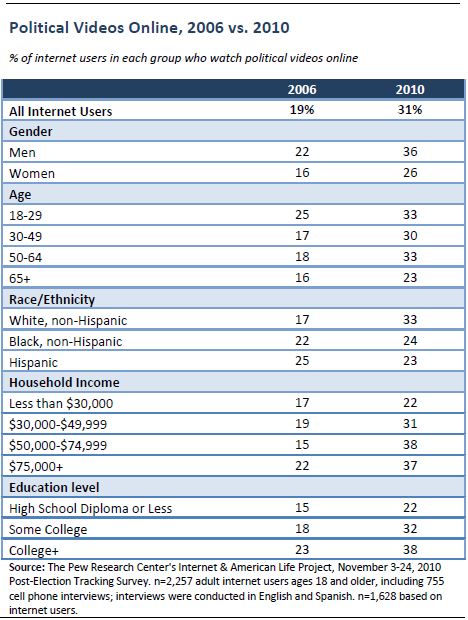
Both Democratic and Republican voters were more likely to watch political videos in 2010 than they were in 2006, and voters of both parties were more likely than non-voters to watch political videos online. Fully 40% of Republican voters who use the internet watched online political videos in 2010, compared with 32% of such Democratic voters and 22% of internet users who did not vote. All told, the proportion of Democratic voters who watched political videos in the months leading up to the election increased by a third between 2006 and 2010, while the proportion of Republican voters doing so doubled over the same time period.
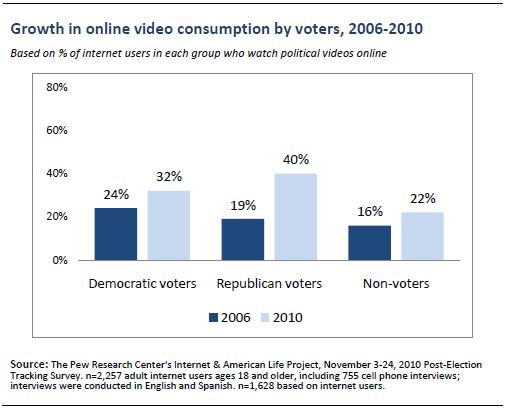
Along with watching videos online, 8% of online adults went online to share photos, videos or audio files related to the election with others. There are relatively few demographic differences when it comes to sharing multimedia content, and voters (for any party) are more likely than non-voters to have done this in 2010.
Online communication and interaction with others
In the months leading up to the election, Americans used the internet to connect and interact with others around the campaign in a number of ways. Among online adults:
- 16% sent email related to the campaign or the elections to friends, family members or others
- 12% revealed online which candidates they voted for in the November elections
- 7% used the internet to organize or get information about in-person meetings to discuss political issues in the campaign
- 6% took part in an online discussion, listserv or other online group forum such as a blog, related to political issues or the campaign
- 5% used the internet to participate in volunteer activities related to the campaign—such getting lists of voters to call or getting people to the polls
Taken together, 27% of adult internet users did at least one of these communication-related activities in the months leading up to the November elections.
Political email
Around one in six adult internet users (16%) sent emails related to the campaign in the months leading up to the November elections. Demographically, sharing political information via email is relatively popular with older adults, as 21% of online 50-64 year olds did this in 2010 (compared with 13% of 18-29 year olds, 15% of 30-49 year olds and 16% of those 65 and older). Sharing political information via email is also popular with college graduates (22% of such internet users did this) and those with a household income of $75,000 or more per year (22%). White internet users are more likely to share political information in this way than African Americans (18% vs. 10%).
In terms of political differences, voters of all kinds are more likely than non-voters to share political emails with others—among internet users 24% of Republican voters and 19% of Democratic voters did this, compared with 8% of non-voters. Similarly, supporters as well as detractors of the Tea Party movement were more likely to use email in this way than were internet users who had not heard of the movement or who did not feel strongly about it one way or the other.
Letting others know who one voted for
One in ten adult internet users who voted in 2010 (12%) went online to reveal who they voted for in the 2010 elections. This behavior is especially prevalent among 18-29 year olds—22% of such internet users did this in 2010, compared with 11% of those ages 30-64 and 6% of those 65 and older.
Get information about in-person meetings or events
Seven percent of adult internet users went online to organize or get information about in-person meetings related to the campaign. There are relatively few demographic differences in this question, although college graduates (12% of such internet users did this in 2010) were more likely to go online for information about in-person political activities than were those with lower levels of education (5% of whom did so). Not surprisingly, those with relatively strong political leanings were more likely than others to go online to find out about offline political events.
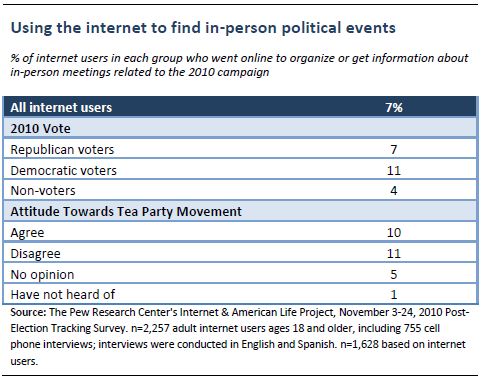
Taking part in political online discussion forums
Six percent of adult internet users took part in an online discussion, listserv or other online group forum related to the campaign or political issues in the months leading up to the 2010 election. Demographically, young adults were more likely than their elders to take part in online discussion groups in 2010—10% of internet users ages 18-29 did this, compared with 6% of 30-49 year olds and 5% of those ages 50 and up. Those internet users who describe their political ideology as liberal (11%) were roughly twice as likely as conservatives (6%) or moderates (5%) to take part in these online forums in 2010.
Using the internet to participate in volunteer activities
Five percent of adult internet users went online in the months leading up to the 2010 elections to participate in volunteer activities related to the campaign, such as getting lists of voters to call or getting people to the polls. This type of online engagement was common among black internet users (9% did this, compared with 4% of whites and 2% of Latinos), and college graduates were somewhat more likely than those with only a high school education to do this. Voters (whether Democratic or Republican) were also more likely than non-voters to use the internet to facilitate political volunteerism.
The internet as a tool for candidate assessment and “fact-checking” of political claims
One-third (35%) of wired adults went online in the months leading up to the November elections to look for information about candidates’ voting records or positions on issues. Demographically, this activity was especially prevalent among college graduates (48% of such internet users did this) as well as those with household incomes of $75,000 or more. White internet users (37% of whom went online to research voting records or candidate positions) were also more likely than blacks (20%) or Latinos (28%) to do this.
28% of online adults used the internet to research or “fact check” claims made during the campaign. As with online political fact checking, this activity is particularly prevalent among whites, college graduates and those with relatively high incomes.
Finally, 8% of online adults signed up online to have updates about the campaign or the election delivered to them directly. Other than college graduates (14% of such internet users signed up for updates about the election) there are relatively few demographic differences on this activity.
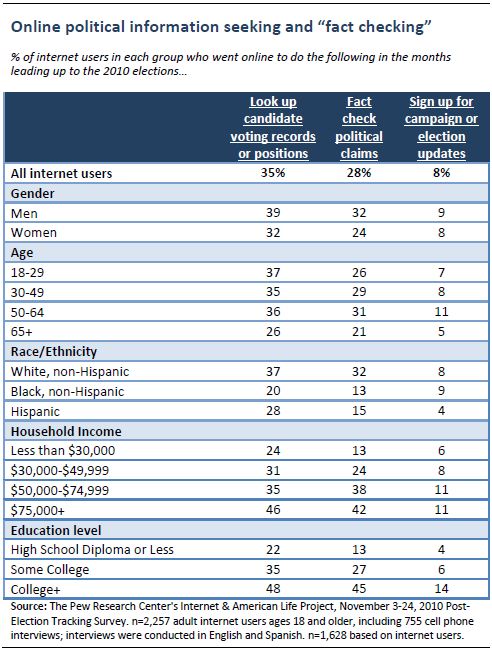
Voters (for any party) were more likely than non-voters to engage in each of these three activities in 2010. Moreover, Republican voters were notably more likely than Democrats to look up candidate voting records or positions, and also more likely to research or fact check claims made during the campaign.
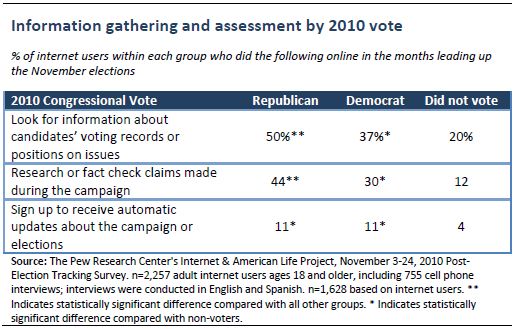
Online political donations
Four percent of internet users went online during the election to donate money to a candidate running for public office, which is comparable to the 3% of internet users who did this during the previous mid-term election in 2006. Unsurprisingly, voters of both parties are more likely than non-voters to have donated money online in 2010 (among internet users 5% of Republican voters and 6% of Democratic voters did so). Similarly, Tea Party supporters (7%) and those who disagree with the movement (5%) were more likely than those who have no opinion (2%) or have not heard of the group (2%) to have donated money online.
The internet as a tool for engagement with out-of-state campaigns
One of the striking uses of the internet has been for voters in one locale to become interested in races in other parts of the country – races in which they could not vote. The 2010 campaign offered a particularly interesting set of circumstances with the rise of the Tea Party movement that was heavily covered in the traditional media and gathered a great deal of debate and chatter in social media like Facebook, Twitter, and political blogs. Certain races like the Senate contests in Florida, Nevada, and Delaware drew widespread attention as Tea Party-backed candidates were in featured in the general election.
Thus, although the 2010 campaign was not a national election, fully 20% of adult internet users said that they went online in the months leading up to the election to follow an interesting election campaign in another part of the country. Men, whites, the relatively affluent and well-educated and those with strong views (either for or against) the Tea Party movement were particularly likely to go online to follow an election campaign elsewhere in the country in 2010.
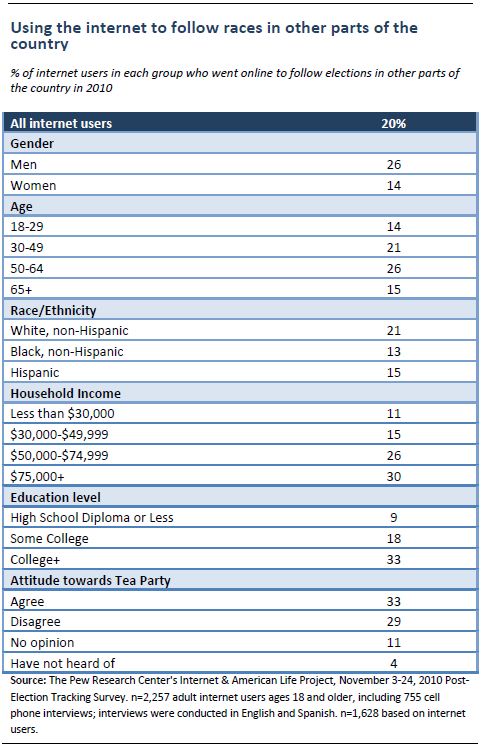
Although one in five online adults used the internet to keep tabs on out-of-state races, a relatively modest number went online to participate in volunteer activities or donate money in campaigns outside of their current state. Of the 5% of internet users who went online to participate in volunteer activities related to the campaign, 15% said that they did this for a campaign in another part of the country. And of the 4% of internet users who donated money online to a candidate or campaign, 24% made a donation to a candidate running for office in a state other than the one they live in. That works out to just 1% of internet users who went online to donate money or volunteer in a campaign outside of their state.




